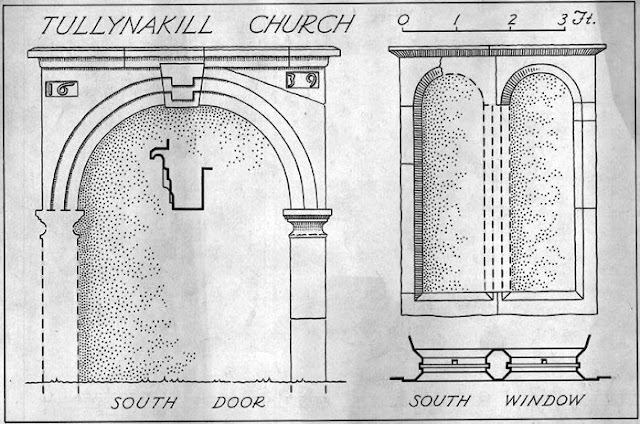Tullynakill Church, Co. Down
Having concluded our visit to Sketrick Castle (Chapple Major: Loved it. Chapples Minor: Unimpressed), we next headed for Tullynakill church. This was to be our fourth archaeological site of the day and the children were getting bored and tired. I did my best to be enthusiastic, but I wasn’t holding out too much hope. While we were at Sketrick the clouds had closed over, the wind had risen, and the temperature dropped. It only looked like it was going to get more miserable. It’s less than three miles from Sketrick to Tullynakill, but somewhere along the way, the clouds parted, the wind ceased to blow, the air grew warm, and the sun shone. We parked the car and made our way onto the site and the atmosphere just felt magical.
Although the majority
of the standing structure is 15th to 16th century, all the decorated stonework
is of 17th century date. In the late 15th century it replaced Nendrum (4 miles away
by road, or 1.5 miles as the crow flies/rows) as the Parish church. Unusually,
for Ireland at least, burial then transferred to Tullynakill, leaving the older
site free of later graves. The original doorway and window, now blocked, can be
seen in the west gable. The later door in the south wall is carved with the
date 1637. As the doorway and the windows are all executed in a similar style and
in the same material (Castle Espie Limestone) it is likely that all date to the
same year. The windows are chamfered and grooved to receive glass. The late
medieval church was last used in 1825 when a newer church was built. This 19th century
structure was itself demolished in the late 20th century.
I did my best with the
Chapples Minor … really I did … I pointed out the doorway and the putlog holes
in the gables and tried to get them interested in some of the gravestones, but
it was all to no avail. The sun was out, the grass was high, and the site was
just perfect for playing hide-and-seek. A little warmth and a flicker of blue in
the sky can do wonders for the spirit – no matter what your age. The Chapples
Minor romped contentedly as I took my photographs and I even joined them for a
little while. As the brief gap in the weather started to close again, we
bundled ourselves back into the car and went in search of the bacon and ice-cream
promised at the beginning of the day. Sometime later, as we waited for three
large bacon sandwiches to arrive, we discussed what the best sites of the day
had been for us. I was of the opinion that each offered something different and
special. The castle and church at Ringhaddy had an ‘off the beaten track’ and ‘difficult
to access’ cachet to them while Sketrick was a very personal ‘got there at last’
feel to it. Not to be outdone, I thought that Tullynakill filled in part of my
education about Nendrum as well as being filled with interesting details in its
own right. While I stand by this assessment, my children were more forthright
and cutting in their views. Both agreed that Tullynakill was – by far – the best
we’d seen as you could have an excellent game of hide-and-seek, while there was
still sufficient space to play chasing games too. Well, folks, if you’ve
followed this series of posts and enjoyed this adventure on our doorstep you now
should have enough information to make an informed decision of where to visit …
























Would it be possible to list the headstones and what's inscribed on them.Its difficult to make out the inscriptions on them from the photos on the site.Is this a mixed burial ground or both protestant and catholic families.Thank you for the site its great.
ReplyDelete